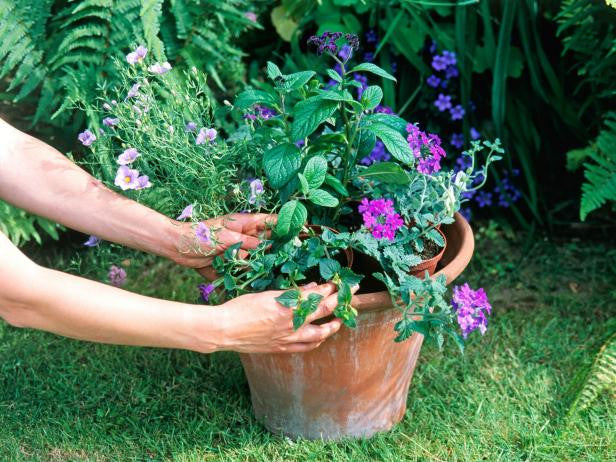Tips for nurturing healthy plants and flowers the organic way.
By: Nan Ondra
Going all-organic in your container plantings follows the same basics as for an in-the-ground garden: building a healthy soil, providing natural sources of nutrients, and using least-toxic options for dealing with pests and other problems.
Start With the Soil
Though you may not realize it, commercial potting soils – also known as growing mixes – often contain synthetic ingredients, such as chemical fertilizers (to provide nutrients) and wetting agents (to make it easier for the potting soil to absorb water when it’s dry). With the growing interest in organic gardening these days, more and more garden centers are stocking organic potting soils, which can be a good option if you have only a few containers to fill, or if you need the convenience of a pre-made growing mix. These commercially made organic mixes tend to be pricey, though, and you still may not know exactly what is in them.
If you’re seriously into container gardening and you really want to know what’s in your potting soil, creating your own mix may be a more cost-effective alternative. There are endless variations on the ingredients and amounts you can use, so you’ll need to do some experimenting before you find the ideal recipe for your own conditions. The very simplest approach is to mix equal parts garden soil and good-quality compost (sifted through a 1/2-inch wire mesh screen to remove any lumps). If the mixture stays too wet, add a coarse material such as sand or perlite to your recipe; if it dries out too quickly, use more compost or peat moss the next time. This sort of mix tends to be very heavy, which can be a problem if you want your containers to be easy to move. For a lighter, soil-less mix, start with equal parts compost or peat moss and perlite.
The Need to Feed
Container gardening presents two challenges when it comes to making sure plants can get the nutrients they need for strong, healthy growth. First, the container limits how far the roots can spread out, so they’re stuck with whatever they can find in the potting soil. And, when you water thoroughly enough for some to run out of the drainage holes, the excess water carries dissolved nutrients out of the potting soil, so it’s completely lost to the roots.
To help to compensate for the limited root space, make sure that there is some organic source of nutrients in the potting mix before planting. If you’re using a mix that contains soil or compost, or a commercial organic potting soil that includes fertilizer, you probably don’t need to worry about adding more nutrients right away; otherwise, blend a dry form of all-purpose organic fertilizer into the potting mix. Flowers and veggies usually benefit from regular doses of liquid organic fertilizer through the growing season, too. Check the directions on the fertilizer packages to find out how much of each to use, and how often to apply them.
Pest Patrol
In many ways, growing plants in containers makes it easy to keep pest and disease problems to a minimum. Because the plants are raised above ground level, they’re less susceptible to damage from slugs, rabbits, and other critters that tend to nibble on garden plants, as well as from soil-borne bacteria and fungi. Keeping containers close to your house makes deer damage less likely, too. And because you frequently see your container plants at close range as you water, fertilize, and groom them, you’ll probably spot any pests before they have a chance to do more than chew a leaf or two.
The quickest and easiest form of organic pest control is literally right at your fingertips: simply pinch off pest-bearing leaves, buds, or shoot tips, or pick off larger pests individually, and drop them into a container of soapy water. (Wear gloves if you’re squeamish.) If you feel you must spray, look for an insecticidal soap spray at your local garden center and apply it according to the directions on the label.






